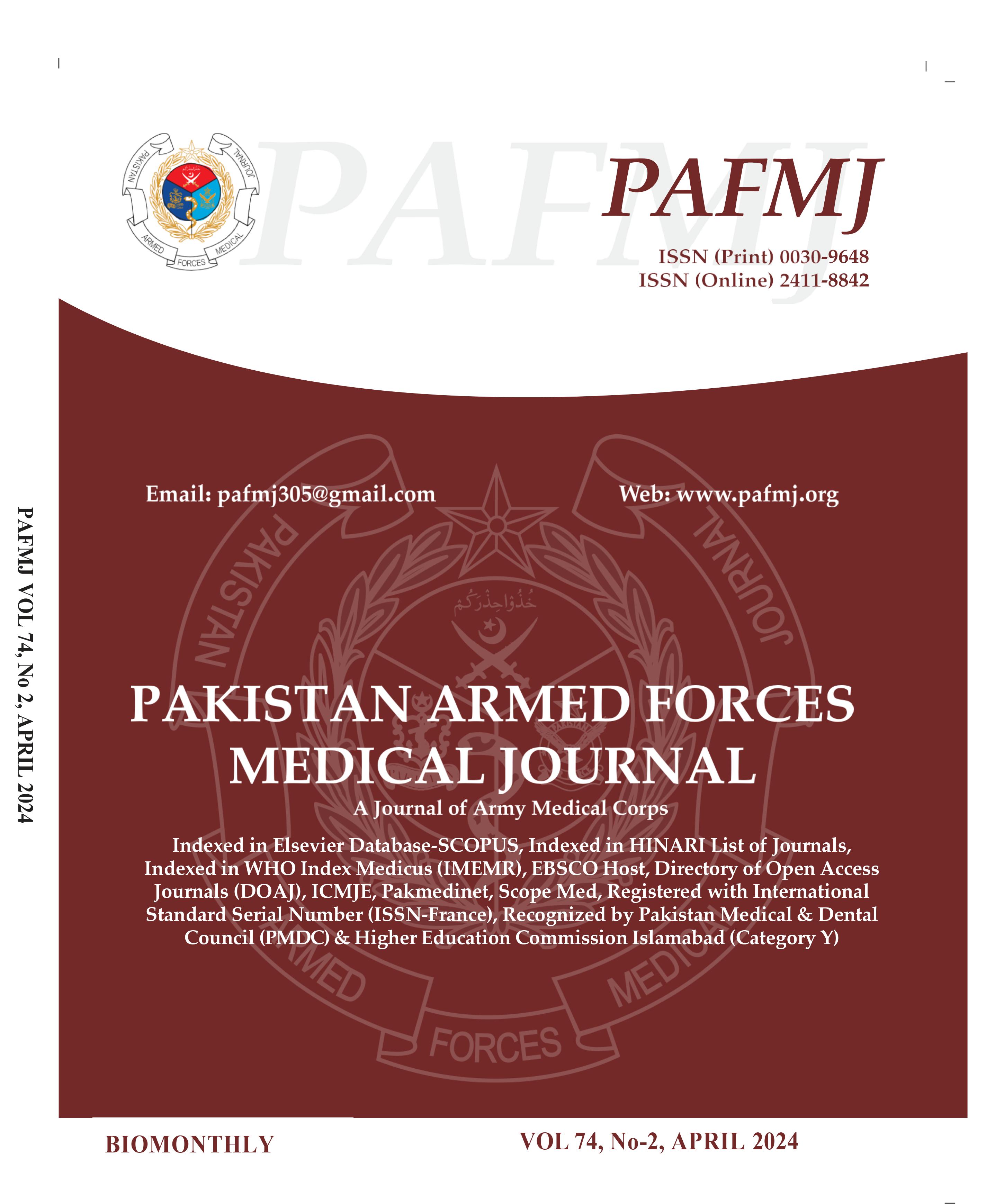A study of Electroencephalography Findings and its Prognostic Value in Severe COVID-19 Patients Admitted at Intensive Care Unit
DOI:
https://doi.org/10.51253/pafmj.v74i2.7446Keywords:
COVID-19, Electroencephalography, Encephalopathy, Electroencephalogram (EEG), Richmond Agitation-Sedation ScaleAbstract
Objective: To study electroencephalography patterns in COVID-19 patients admitted to intensive care unit and find the association of these patterns with outcome.
Study Design: Comparative cross-sectional study.
Place and Duration of Study: Intensive Care Unit, Pak Emirates Military Hospital, Rawalpindi Pakistan, from Nov 2020 to Mar 2021.
Methodology: Eighteen electroencephalograms in COVID-19 patients with Encephalopathy were recorded using a 10-20 electrode system. The duration of each recording was 30 minutes. Traces were analysed by a neurologist for delta slowing, epileptiform discharges, and posterior dominant rhythm. Generalised slowing was classified as mild (background slowing), moderate (intermittent slowing) and severe (continuous slowing).
Results: A total of 18 COVID-19 patients, with a mean age of 63±16.02 years, underwent electroencephalography recording of 30 min duration. Diabetes mellitus and ischemic heart disease were the most common co-morbidity (7, 38.9%), followed by CKD. Non-specific generalised slowing was observed in all EEGs. No epileptiform discharges or focality were seen. Posterior Dominant Rhythm has been related to a good outcome. At the same time, severe Encephalopathy (Richmond Agitation-Sedation Scale of -3 to -5) was associated with poor outcomes (p-value<0.05).
Conclusion: Patients with Posterior Dominant Rhythm had more chances of having good outcomes, while patients with severe encephalopathy findings on EEG were more at risk of poor outcomes.
Downloads
References
Ahmad I, Rathore FA. Neurological manifestations and complications of COVID-19: A literature review. J Clin Neurosci 2020; 77: 8-12. https://doi.org/10.1016/j.jocn.2020.05.017
Nepal G, Rehrig JH, Shrestha GS, Shing YK, Yadav JK, Ojha R, et al. Neurological manifestations of COVID-19: a systematic review. Crit Care 2020; 24(1): 421.
https://doi.org/10.1186/s13054-020-03121-z.
Sharifian-Dorche M, Huot P, Osherov M, Wen D, Saveriano A, Giacomini PS, et al. Neurological complications of coronavirus infection; a comparative review and lessons learned during the COVID-19 pandemic. J Neurol Sci 2020; 417: 117085.
https://doi.org/10.1016/j.jns.2020.117085.
Schmitt SE. Utility of Clinical Features for diagnosing Seizures in the Intensive Care sUnit. J Clin Neurophysiol 2017; 34(2): 158-161.
https://doi.org/10.1097/WNP.0000000000000335.
Claassen J, Mayer SA, Kowalski RG, Emerson RG, Hirsch LJ. Detection of electrographic seizures with continuous EEG monitoring in critically ill patients. Neurology 2004; 62(10): 1743-1748. https://doi.org/10.1212/01.wnl.0000125184.88797.62.
Hirsch LJ. Continuous EEG monitoring in the intensive care unit: an overview. J Clin Neurophysiol 2004; 21(5): 332-340.
Young GB. Continuous EEG monitoring in the ICU: challenges and opportunities. Can J Neurol Sci 2009; 36 Suppl 2: S89-91.
Mao L, Jin H, Wang M, Hu Y, Chen S, He Q, et al . Neurologic Manifestations of Hospitalised Patients With Coronavirus Disease 2019 in Wuhan, China. JAMA Neurol 2020; 77(6): 683-690.
https://doi.org/10.1001/jamaneurol.2020.1127.
Beigel JH, Tomashek KM, Dodd LE, Mehta AK, Zingman BS, Kalil AC, et al. Remdesivir for the treatment of COVID-19—preliminary report. N Eng J Med 2020; 383(19): 1813-1836.
Ahmad I, Rathore FA, Khan MN, Nazir SN. Risk factors associated with in-hospital death in adult COVID-19 patients in Karachi, Pakistan: a retrospective chart review. Pak Armed Forces Med J 2020; 70(1): S347-353.
Li YC, Bai WZ, Hashikawa T. The neuroinvasive potential of SARS-CoV2 may play a role in the respiratory failure of COVID-19 patients. J Med Virol 2020; 92(6): 552-555.
https://doi.org/10.1002/jmv.25728.
Helms J, Kremer S, Merdji H, Clere-Jehl R, Schenck M, Kummerlen C, et al . Neurologic Features in Severe SARS-CoV-2 Infection. N Engl J Med 2020; 382(23): 2268-2270.
https://doi.org/10.1056/NEJMc2008597.
Canham LJW, Staniaszek LE, Mortimer AM, Nouri LF, Kane NM. Electroencephalographic (EEG) features of Encephalopathy in the setting of Covid-19: A case series. Clin Neurophysiol Pract 2020; 5: 199-205. https://doi.org/10.1016/j.cnp.2020.06.001.
Louis S, Dhawan A, Newey C, Nair D, Jehi L, Hantus S, et al. Continuous electroencephalography characteristics and acute symptomatic seizures in COVID-19 patients. Clin Neurophysiol 2020; 131(11): 2651-2656.
https://doi.org/10.1016/j.clinph.2020.08.003.
Galanopoulou AS, Ferastraoaru V, Correa DJ, Cherian K, Duberstein S, Gursky J, et al . EEG findings in acutely ill patients investigated for SARS-CoV-2/COVID-19: A small case series preliminary report. Epilepsia Open 2020; 5(2): 314-324. https://doi.org/10.1002/epi4.12399.
Chen W, Toprani S, Werbaneth K, Falco-Walter J. Status epilepticus and other EEG findings in patients with COVID-19: A case series. Seizure 2020; 81: 198-200.
https://doi.org/10.1016/j.seizure.2020.08.022.
Filatov A, Sharma P, Hindi F, Espinosa PS. Neurological Complications of Coronavirus Disease (COVID-19): Encephalopathy. Cureus 2020; 12(3): e7352.
https://doi.org/10.7759/cureus.7352.
Pellinen J, Carroll E, Friedman D, Boffa M, Dugan P, Friedman DE, et al. Continuous EEG findings in patients with COVID-19 infection admitted to a New York academic hospital system. Epilepsia 2020; 61(10): 2097-2105.
https://doi.org/10.1111/epi.16667.
Skorin I, Carrillo R, Perez CP, Sanchez N, Parra J, Troncoso P, Uribe-San-Martin R. EEG findings and clinical prognostic factors associated with mortality in a prospective cohort of inpatients with COVID-19. Seizure 2020; 83: 1-4.















